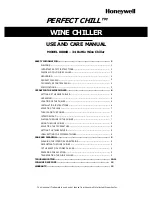
Use
20
Dessert wines and fortified wines
These two types of wine generally both
contain a high alcohol percentage and
they are both often also sweet. However,
there are dry dessert wines, such as
Marsala, with a sugar content so low as to
be almost imperceptible on the palate. For
these wines, the serving temperature
depends on which features you wish to
emphasise. If you prefer to accentuate the
wine's sweetness, the complexity of its
bouquet and its austerity, it should be
served at a high temperature, between
14°C and 18°C. Remember that in this
case its alcohol content will also be more
noticeable.
If you require a fresher sensation, or to
reduce the sweetness of over-sweet wines,
serve at a lower temperature, between
10°C and 14°C.
Young, fresh, dry dessert wines can be
served at colder temperatures, below
10°C. This makes the alcohol content
considerably less noticeable. However,
remember that as the temperature is
reduced the bouquet also becomes less
evident. One of these wines' key
characteristics is the charm and complexity
of their bouquet; serving them too cold also
means sacrificing this important feature.
Storage temperatures
To enjoy the flavour and bouquet of each
wine at its best, it should be stored and
drunk at a specific temperature. The
recommended temperatures for different
kinds of wines are given below.
Type of wine
Temperature
Young whites
10°C - 12°C
Mature whites
12°C - 14°C
Young, light rosés
10°C - 12°C
Mature, full-bodied rosés
12°C - 14°C
Nouveau reds
10°C - 14°C
Young, light reds with low
tannins
14°C - 16°C
Mature, full-bodied reds with
high tannins
16°C - 18°C
Very mature and cask-aged
reds
16°C - 18°C
Sweet and aromatic sparkling
wines
8°C
Sweet and aromatic red
sparkling wines
10°C - 12°C
“Charmat method” sparkling
wines
8°C - 10°C
“Long Charmat method”
sparkling wines
10°C - 12°C
“Traditional method” sparkling
wines without year
8°C - 10°C
“Traditional method” sparkling
wines with year
10°C - 12°C
Dessert wines
10°C - 18°C
Fortified or liqueur wines
10°C - 18°C







































